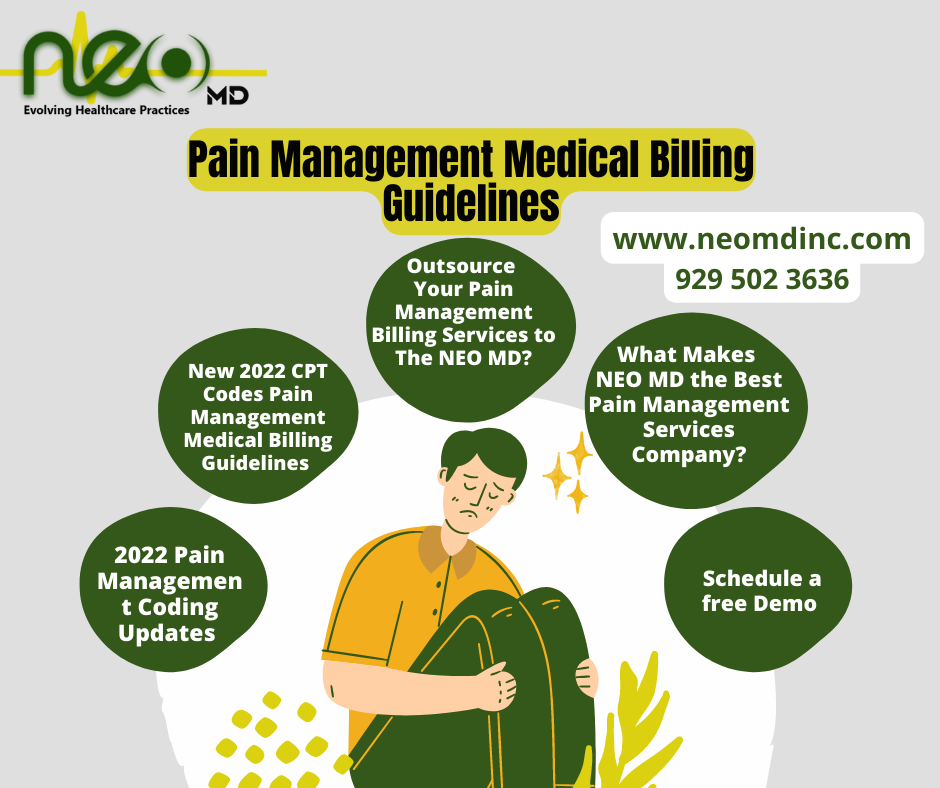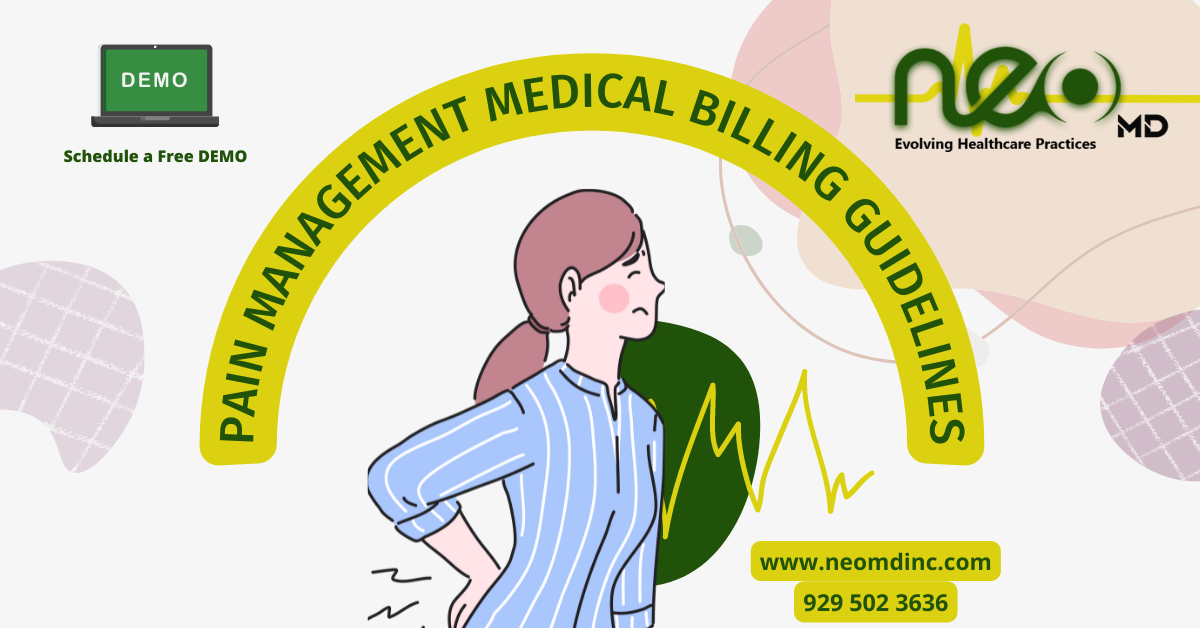Every year, billing and coding for pain management services become significantly more challenging. As millions of Americans suffer from severe and chronic pain, new pain management medical billing guidelines are getting attention from the medical community. Payers and regulators closely monitor the approaches used to manage chronic pain. Therefore, emphasis should be made on correctly handling billing and coding for pain management. By collaborating with pain management medical billing companies, medical practices may manage their revenue cycle effectively.
Medical coders must be well-versed in both medical jargon and the intricacies of the coding procedures. To better comprehend the language of the new codes, they must review anatomy and physiology fundamentals. To further improve their skills, coders must attend pain management coding webinars hosted by several regional and government agencies.
In this article, we’ll find out how medical facilities successfully ensure new 2022 pain management medical billing guidelines.
Correct compliance to Pain Management Medical Billing Guidelines
With millions of Americans experiencing severe and ongoing pain, chronic pain management has become a serious public health concern. It costs the government billions in productivity loss and time, as well as has a tremendous effect on people’s lives. An estimated 50 million Americans, or 20.4% or 1 in 5 individuals, have chronic pain, according to a CDC poll. Half the battle in increasing practice revenue is successfully enforcing Pain Management Medical billing guidelines and coding compliance. Billing for pain management has become more difficult as a result of new state and federal regulations.
Recently, pain management has had to deal with billing issues that include raising patient financial obligations, reducing fee schedules, and extending prior authorization requirements. After recognizing and understanding these issues, there are suggestions to reduce your suffering and enhance your pain management billing collection.
Documentation of Pain Management Services
The presence of medical records assures the necessity of every procedure. Likewise, pain management documentation (PMD) is essential for ensuring pain management medical billing guidelines in recording patient treatment. It is a way for health workers to converse with one another about patients’ problems, treatments, and reactions. Documentation of pain management should be accurate and thorough in order to decrease the possibility of claim denials. When providing information discovered in notes to the business department, coders must be competent in clarifying the data and applying the most recent coding recommendations when coding it.
Rectify mistakes in medical records
Finalizing documentation is essential to ensure that payers pay for treatments and effectively handle medical record flaws. Doctors should never remove the text or use correction fluid in patient records. If a mistake is discovered in a patient’s medical history, it must be amended after a single phrase is crossed out in ink with the word “error” above it. Additionally, any record corrections must have the approval of the treating physicians. Coding is the essence of submitting an error-free claim that yields healthy revenue. It all happens correctly when the coder ensures the CMS pain management medical billing guidelines while filling the claim for patient treatment.
Keep Up to Date with Payer Policies and Pain Management Billing Guidelines
Considering that there are several suppliers, coders, and insurance companies. To maximize compensation, it is essential to stay current on insurance payer policy changes. This calls for investigation activities to gather information from changes and data obtained from several payers. The most important coding and billing changes are often announced in the previous year’s fourth quarter, with January 1st effective dates. However, over the year, information might change. For instance, changes made to telemedicine during the COVID-19 pandemic affected ICD-10-CM and patient E/M codes.

Fewer denials and faster insurance reimbursements will come from compliance with payer Pain Management Medical Billing Guidelines and recommendations. Calling the insurance provider in the case of a problem might provide further details and avoid late payments. Insurance companies often update their billing guidelines and policies and post them on their websites and provider portals. You can keep up with payer standards and regulations by educating your medical billing and coding staff.
Avoid Billing Procedures Based on Summaries
Charging a procedure based only on a summary is one of the most typical mistakes in pain management billing and coding guidelines. Medicare specifies that you can only submit claims for procedures described in the report’s text. It means that for coding purposes, programmers need to do more than just skim the material.
Billing for Fluoroscopy
Most pain management providers frequently commit the blunder of billing fluoroscopy individually. Fluoroscopy is necessary for several pain management procedures, including discography, articular joint, spinal steroid injections, and radiofrequency ablations.
Make sure you understand whether the utilized therapy is paid for collectively, as in the case of medial branch blocks, facet injections, and the SI joint (27096), or whether it is paid for separately, as in the case of fluoroscopic guidance codes for peripheral joints. Your claims will be rejected because they are duplicates if you bill for fluoroscopy individually.
Employing Modifiers (Pain Management Medical Billing Guidelines)
Applying the incorrect modifiers may result in claim denials, whereas utilizing the proper modifiers clarifies the procedure. Pain management medical billing guidelines typically use the following modifiers:
In terms of anatomy, -LT signifies left and -RT indicates right.
50: Bilateral operation
59: Implies a service or activity’s uniqueness and distinctiveness from other services provided on the same day.
52: incomplete process; delaying a portion of the treatment for purposes unrelated to the patient’s welfare.
53: incomplete process; the surgeon decides to halt the procedure for the patient’s safety.
A bilateral surgery must use modifier -50, which signifies simultaneous operations on both sides of the patient.
Why Choose the NEO MD for Your Pain Management Billing Services?
Recognizing all the resources needed to implement pain management medical billing rules is crucial. A thorough understanding of the regulations can significantly reduce the likelihood of coding mistakes while billing the patient’s treatment. Thus, our team will help you increase profitability by keeping track of, measuring, and controlling each part of your revenue cycle.
The NEO MD team provides top-notch medical billing expertise and pain management coding resources. Additionally, in order to collect client payments on time, we have developed flexible revenue cycle management services that genuinely fit provider demands. Obtaining funding from each source may increase your clinic’s profitability while ensuring its ability to pay for medical services.
The medical billing companies have a direct impact on your revenue cycle management. For medical practices to remain competitive in the market over longer periods of time, long-term revenue cycle management is necessary. By working with a medical billing company with knowledgeable and trained coding employees, you can ensure compliance with your revised CMS Pain Management Medical Billing Guidelines. NEO MD has made significant progress in providing medical billing services to healthcare providers. Additionally, NEO has been ranked first among its rival Revenue Cycle Management Companies for specialized medical billing services.
What Makes NEO MD the Best Pain Management Services Company?
NEO MD stood best among competitors due to ensuring the latest CMS Pian Management medical billing guidelines in coding services;
- Our experts work hard to reduce your front-end denials by 20%.
- Offer internal Medical Billing audits to uncover loopholes
- Improve RCM system efficiency with a robust credentialing team.
- Use the latest technology and tools.
- Offer Provider & Staff Productivity Analysis
- Refunds adjustment and Payment posting to improve the cash flow.
- Provide fortnightly financial and practice overviews
- Offer Services that are easily scalable at all times.
- Provide Pain Management Billing Guidelines and collection services that are of high quality and error-free.
- Out of Network Negotiations.
- Deliver customized Revenue Cycle Management Services to unearth operation shortcomings.
- Identify potential under, over, and incorrect coding scenarios
We have consistently increased the collection rate for our clients because of the faster increase in the accuracy of fees and collection.
Let’s schedule an appointment and discuss it in-depth with Medical Billing and Coding specialists. Contact us now at ([email protected]) or (929) 502-3636).







